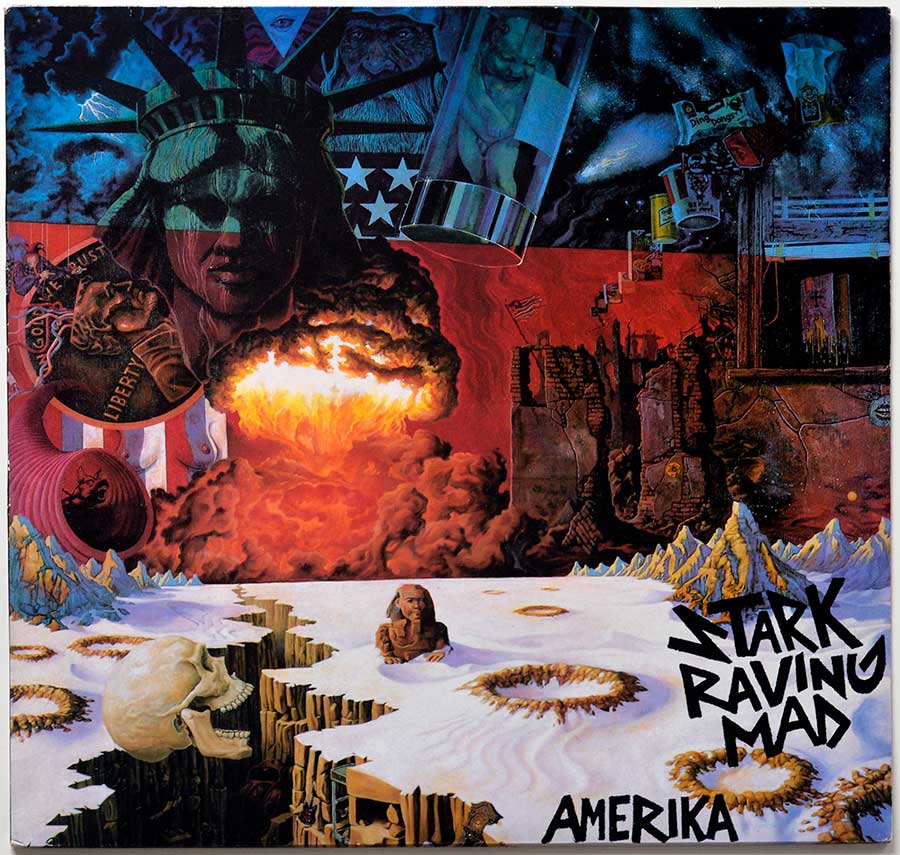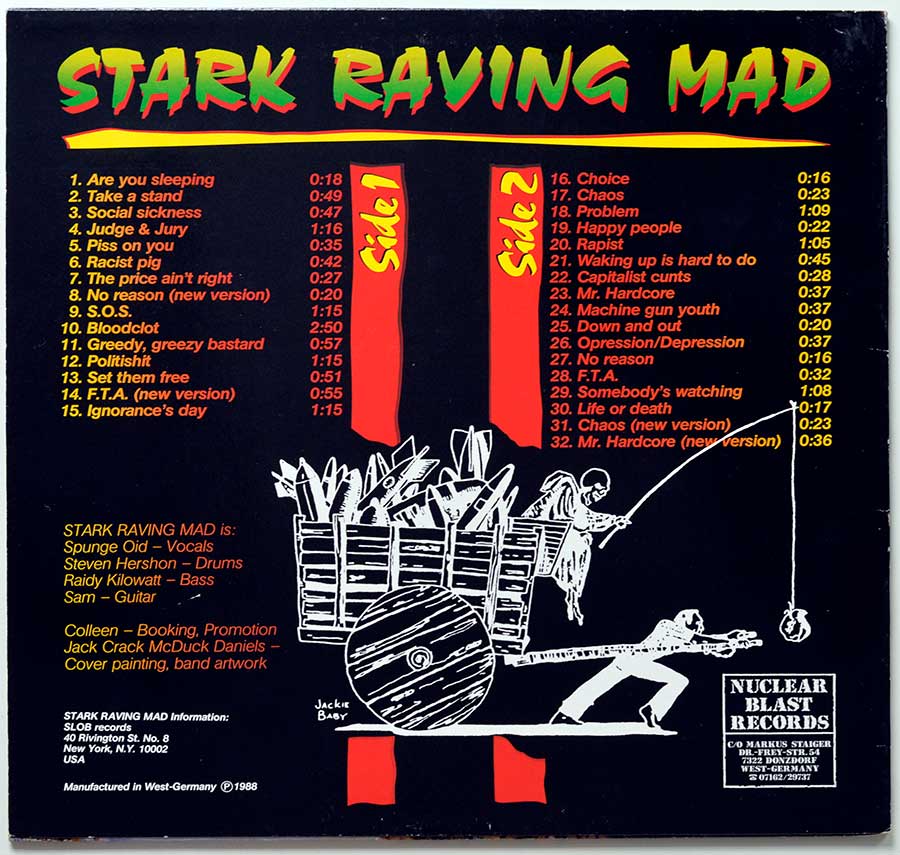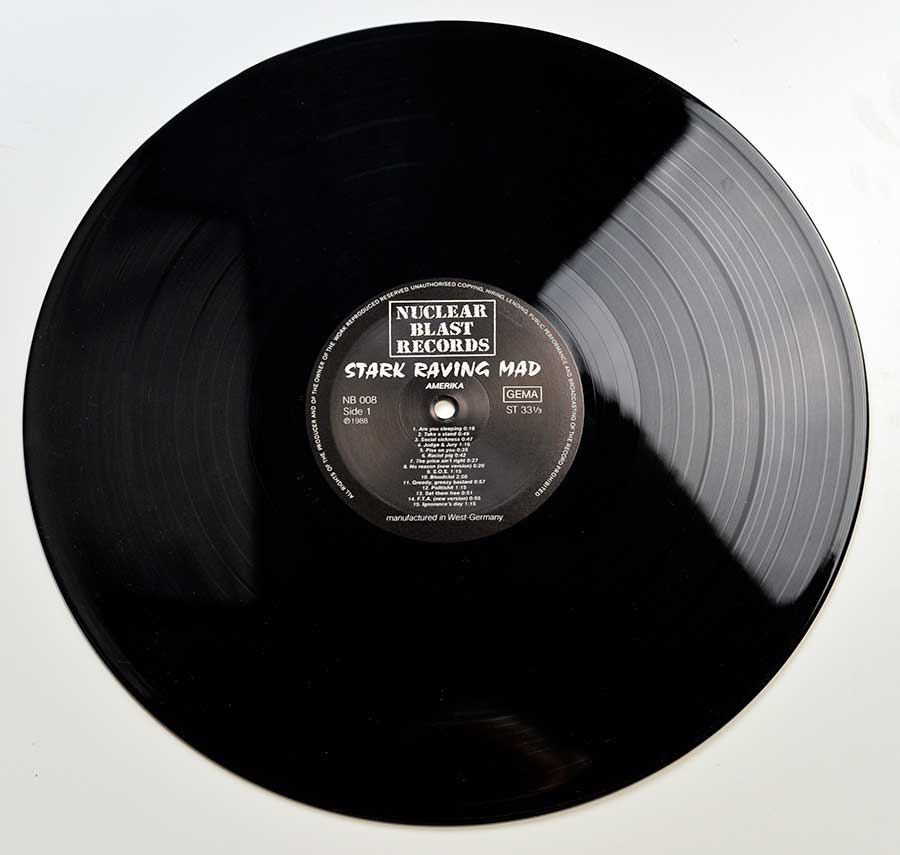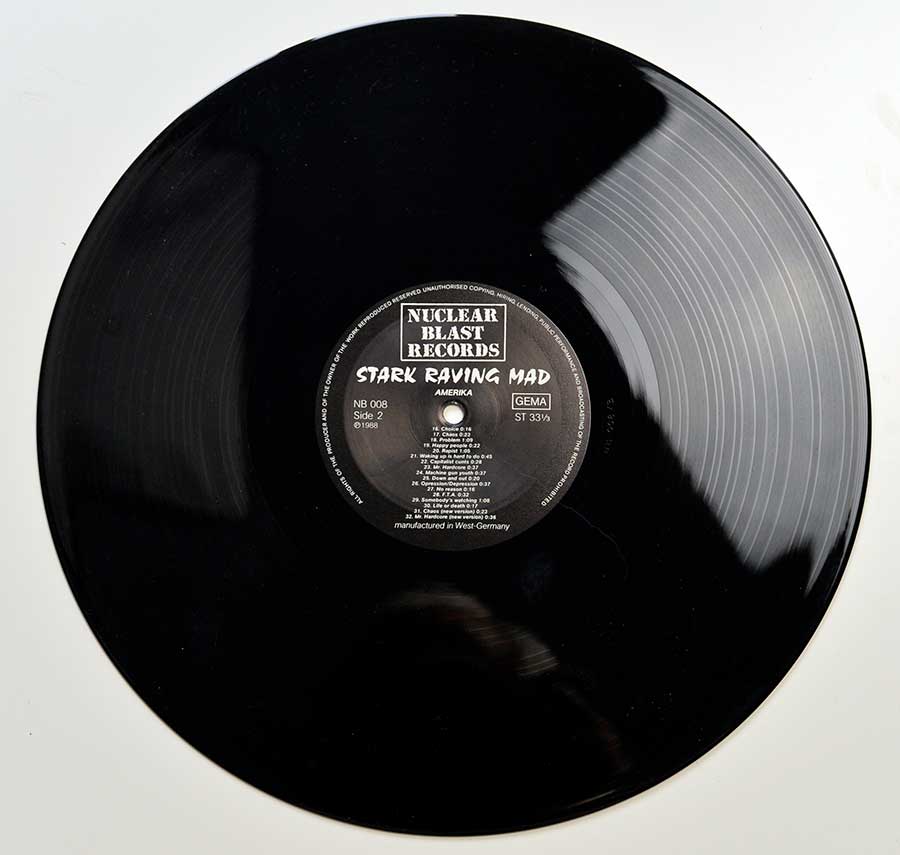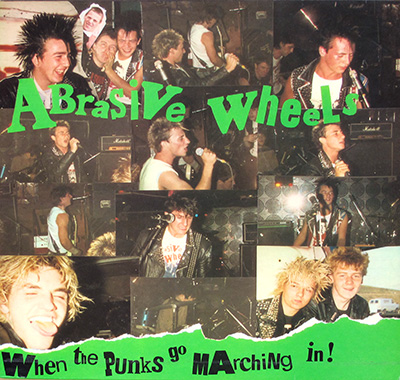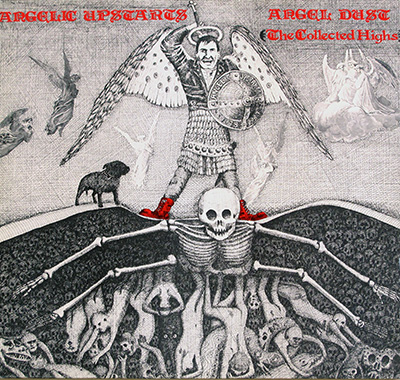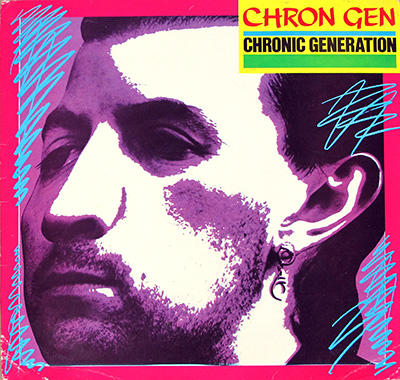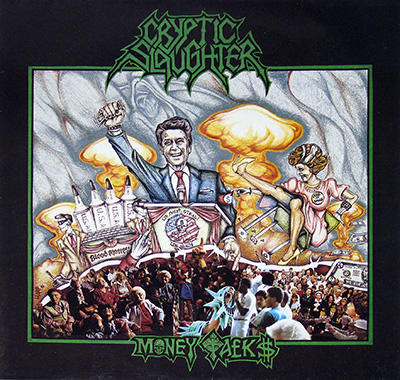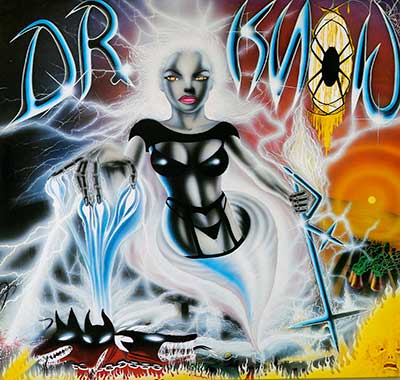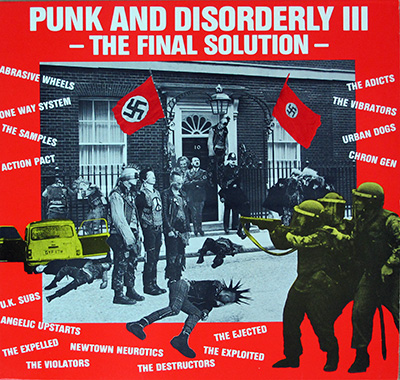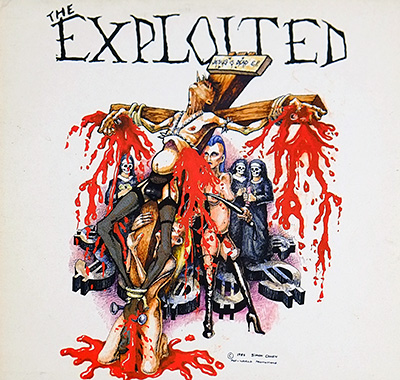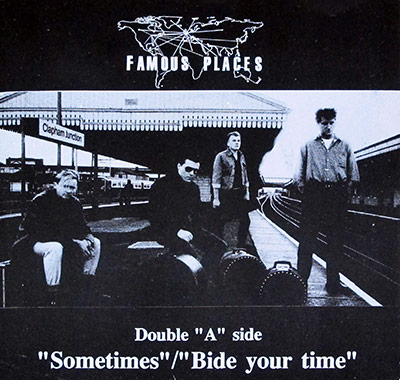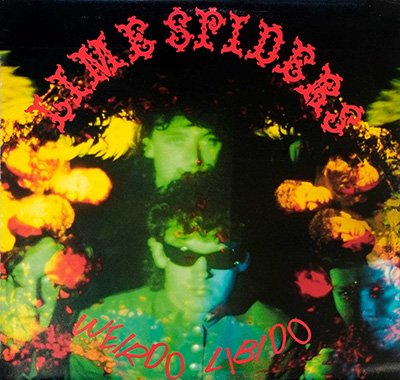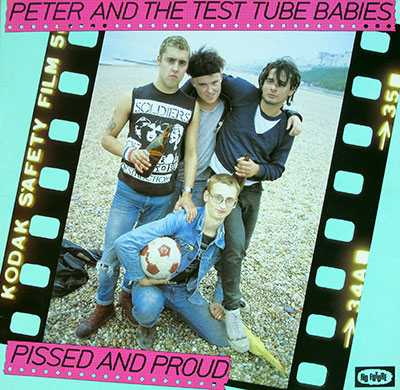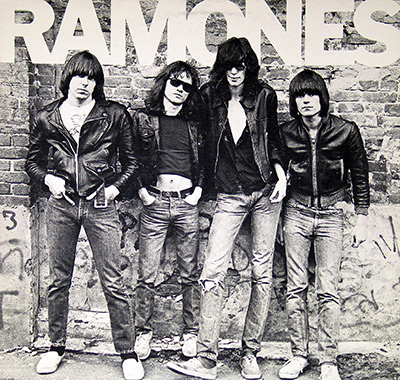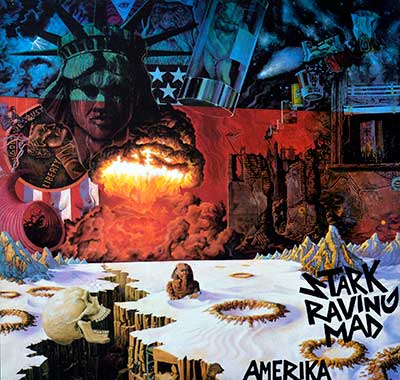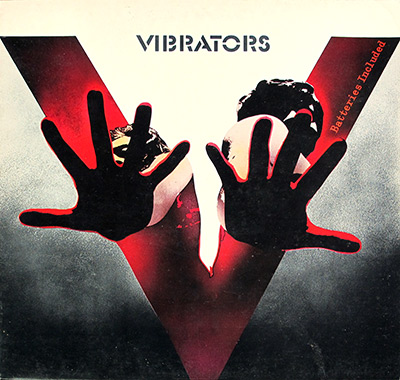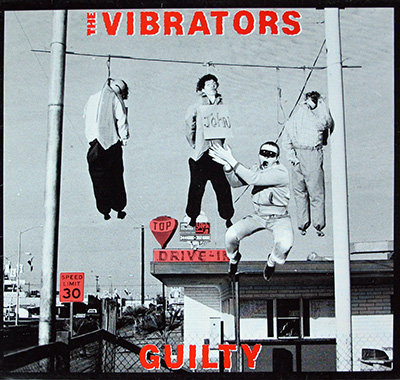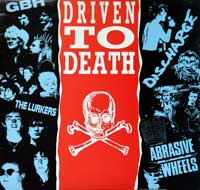Stark Raving Mad: Texas Hardcore Punk in the 1980s
Stark Raving Mad was a hardcore punk band formed in the early 1980s by a group of Texas punks who channeled the era’s rage and energy into ferocious music. Active mainly from 1983 to 1986, Stark Raving Mad built a reputation for ultra-fast songs, politically charged lyrics, and a DIY ethos typical of the 1980s hardcore scene. This in-depth feature explores the band’s biography – from its roots and major recordings to key performances and eventual dissolution – as well as profiles of the band members, an analysis of the Reagan-era climate that shaped their music, and their cultural legacy in both the Texas and national hardcore punk scenes.
Stark Raving Mad was a hardcore punk band formed in the early 1980s by a group of Texas punks who channeled the era’s rage and energy into ferocious music. Active mainly from 1983 to 1986, Stark Raving Mad built a reputation for ultra-fast songs, politically charged lyrics, and a DIY ethos typical of the 1980s hardcore scene. This in-depth feature explores the band’s biography – from its roots and major recordings to key performances and eventual dissolution – as well as profiles of the band members, an analysis of the Reagan-era climate that shaped their music, and their cultural legacy in both the Texas and national hardcore punk scenes.
Formation and Early Years (1982–1984)
Stark Raving Mad’s story begins with Pissed Youth!, a precursor band formed in Houston, Texas in 1982. Pissed Youth featured vocalist Jeff “Sponge” Tunches, drummer Steve Hershon, bassist Barry D’Live, and guitarist Charles (last name uncertain). They were part of the first wave of Texas hardcore punk, influenced by the era’s hardcore icons like Dead Kennedys and Black Flag, as well as local Texas peers D.R.I. and M.D.C.. From the outset, the band embraced provocative political expression – their first DIY t-shirt design showed Sponge grabbing U.S. President Ronald Reagan by the collar, a stark illustration of the hostility many punk youth felt toward authority in the Reagan era. Pissed Youth gigged at Houston’s punk haven, The Island, delivering short, explosive sets that captured the raw anger of Texas hardcore.
In 1983, Pissed Youth underwent a major transition that gave birth to Stark Raving Mad. After a stint living and practicing in San Francisco’s infamous communal punk space the Vats, the band experienced lineup turmoil: bassist Barry D’Live quit, prompting a return to Houston where they recruited Sam Blanton – formerly the drummer of a local band called Doomsday Massacre – to take over on bass. The group then relocated to New York City, seeking a broader scene. There they played a CBGB’s matinee with Suicidal Tendencies while still under the Pissed Youth name. When guitarist Charles abruptly quit on the eve of a show at NYC’s SIN (Safety in Numbers) Club (where they were slated to play with MDC), the remaining members regrouped and reconfigured. Sam Blanton switched from bass to guitar, and the band brought in a new bassist, Bob “Byte” Wilson. “Older, more pissed off, and madder than ever,” as they later put it, the musicians renamed themselves Stark Raving Mad in 1983. The revamped lineup — Jeff Tunches on vocals, Sam Blanton on guitar, Bob “Byte” Wilson on bass, and Steve Hershon on drums — became the core of Stark Raving Mad’s classic era.
Settled in New York, Stark Raving Mad honed their sound with nightly rehearsals in a Brooklyn loft belonging to a friend, Justin Tentler. The band’s very first show under the new name was an auspicious pairing with Arizona skate-punk group Jodie Foster’s Army (JFA) at a New Jersey venue. Balancing day jobs with their musical pursuits, the members pooled their earnings to record their debut. In true DIY fashion, they booked time at Noise New York studio and recorded a blistering set of songs. In 1984 they self-released their first record, a 45 RPM 12-inch EP initially self-titled Stark Raving Mad. They pressed 1,000 copies of this debut and even photocopied the lyric sheets by hand. Thanks to its striking cover art (an image contributed by artist “Jack Crack McDuck Daniels”), the EP soon became colloquially known as “MX”. The title “MX” alluded to the MX missile – a Cold War era U.S. nuclear missile – reflecting the band’s habit of infusing social and political commentary into their work. The MX EP encapsulated Stark Raving Mad’s sound: extremely fast, short tracks (many under a minute) with confrontational lyrics attacking hypocrisy, apathy, and fascist behavior. It earned praise in underground circles; Maximum Rocknroll lauded the record as “a real gem of a thrash record,” noting its “short, sweet, and vicious blitz attacks” in the vein of fellow Houstonians D.R.I.. The band promoted MX via mail-order ads in fanzines like Maximum Rocknroll and Thrasher magazine, and gained support from punk radio DJ Steve Kaye, who featured them on his WUSB “Turmoil” show on Long Island and even interviewed the band on-air.
Return to Texas and Amerika (1985–1986)
Shortly after releasing MX in 1984, Stark Raving Mad decided to leave New York and move back to Texas. The draw of the Houston scene and personal ties pulled them home. Upon returning, they found a receptive local hardcore community. They played gigs at Houston’s Cabaret Voltaire, a club run by promoter Ronnie Gaitz that had become a hub for punk shows. Local radio support came from DJ Chuck Roast of KPFT, who gave Stark Raving Mad generous airplay on his late-night hardcore program “Funhouse”. During this period, the band also refreshed its lineup at bass. Bob “Byte” Wilson, who had been the bassist through the MX era, parted ways (he remained in New York). In his place, Howard “Raidy Kilowatt” Mendez joined on bass by 1985. With Mendez (nicknamed “Raidy K.”) on bass, Stark Raving Mad wrote and recorded their second release.
In 1985 the band entered Rampart Studios in Houston to cut a new 12-inch record. The result was Amerika, another 45 RPM 12″ release featuring a barrage of faster-than-light hardcore tracks. They named the record Amerika with a “k,” inspired by a 6-foot-square oil painting by their artist friend Jack (the same artist from MX) that was used as the album cover. The spelling “Amerika” evoked a critique of the American establishment (a stylistic choice many punk artists used to suggest a dystopian or fascist version of America). Indeed, the album’s songs took aim at social ills like racism, blind patriotism, and authoritarianism – song titles included “Racist Pig” and “Are You Sleeping?”, and the band even experimented by featuring a saxophone guest (musician David Sawyer) on one track, an unusual move in hardcore.
With two records under their belt, Stark Raving Mad hit the road to bring their music to a wider audience. They undertook DIY tours across parts of the U.S. in 1984 and 1985, piling band members, gear, and even a pet cat (an adopted feline named Onyx) into a single van for long drives. Notable gigs punctuated this period. In late 1985, Stark Raving Mad had the high-profile opportunity to open for the Dead Kennedys – one of the era’s biggest punk acts – at a show in New Orleans. Sharing the bill with Dead Kennedys was a milestone for the Texas punks, underscoring how their reputation had grown within the hardcore circuit.
However, by 1986 the band’s run was coming to an end. Stark Raving Mad’s final show took place at the legendary CBGB’s club in New York City in 1986. In a fitting full-circle moment, they returned to the CBGB stage where they’d first made a mark years earlier. That last performance was marked by camaraderie and experimentation: Colleen (Steve Hershon’s wife and the band’s longtime behind-the-scenes supporter) joined on bass for the first half of the set, and former bassist Bob “Byte” Wilson – as a favor – flew in to play bass for the second half. The inclusion of a saxophone on some songs during this finale (courtesy of David Sawyer) shocked some hardcore purists but also demonstrated the band’s willingness to push boundaries even at the end. After this show, Stark Raving Mad disbanded in 1986, closing the chapter on their initial run.
Stark Raving Mad was a hardcore punk band formed in the early 1980s by a group of Texas punks who channeled the era’s rage and energy into ferocious music. Active mainly from 1983 to 1986, Stark Raving Mad built a reputation for ultra-fast songs, politically charged lyrics, and a DIY ethos typical of the 1980s hardcore scene. This in-depth feature explores the band’s biography – from its roots and major recordings to key performances and eventual dissolution – as well as profiles of the band members, an analysis of the Reagan-era climate that shaped their music, and their cultural legacy in both the Texas and national hardcore punk scenes.
Shortly after releasing MX in 1984, Stark Raving Mad decided to leave New York and move back to Texas...
In 1985 the band entered Rampart Studios in Houston to cut a new 12-inch record...
With two records under their belt, Stark Raving Mad hit the road to bring their music to a wider audience...
However, by 1986 the band’s run was coming to an end. Stark Raving Mad’s final show took place at the legendary CBGB’s club in New York City in 1986...
Timeline of Key Events
- 1982: Formation of Pissed Youth! in Houston, TX with Jeff “Sponge” Tunches, Steve Hershon, Barry D’Live, and Charles. Fast hardcore and anti-Reagan imagery.
- 1983: Pissed Youth relocates to SF and NYC. Sam Blanton joins; band becomes Stark Raving Mad.
- 1984: Release of debut EP Stark Raving Mad (aka "MX") on Slob Records. 1,000 copies. DIY promotion.
- 1985: Return to Houston. Bob Wilson out, Howard "Raidy Kilowatt" Mendez in. Record Amerika. Tour includes Dead Kennedys support slot.
- 1986: Final show at CBGB’s with Colleen and Bob Wilson on bass. Band disbands.
- 1988: Nuclear Blast Records reissues MX and Amerika as a compilation LP (white vinyl).
- 1989: Release of Social Sickness on Nuclear Blast – new versions and final CBGB’s live recording.
- 1995: Brief reunion attempt with Sam, Steve, and Colleen. Ends with Steve Hershon’s passing.
- 2007: CD reissue of MX and Amerika via Just 4 Fun Records, bringing the music to new fans.
Band Members and Their Paths
Despite their short run, Stark Raving Mad’s members each left an imprint on the punk scene. Below are brief biographies of the key individuals involved in the band, including their roles, musical backgrounds, and later pursuits or status:
Jeff “Sponge” Tunches – Vocals
Jeff Tunches, better known by his nickname “Sponge” or “Spunge Oid,” was the fiery frontman of Stark Raving Mad. Hailing from Houston, Jeff was the voice and lyrical mouthpiece of the band, noted for his high-pitched, impassioned shouting style often compared to Dead Kennedys’ Jello Biafra.
Before Stark Raving Mad, Jeff was the founding vocalist of Pissed Youth (circa 1982) and helped shape that band’s politically charged stance. In Stark Raving Mad, his lyrics pulled no punches – he railed against social injustice, war, and hypocrisy, channeling the angst of the Reagan years. Songs like “Choice,” “Chaos,” and “Racist Pig” featured Sponge’s rapid-fire screams condemning societal ills.
After the band’s breakup in 1986, Jeff Tunches stepped out of the public punk spotlight. He did participate in the attempted 1995 reunion, rehearsing new songs with Sam and Steve. In later years, Jeff remained proud of Stark Raving Mad’s legacy and was involved in compiling their music for re-releases (the detailed band history on the 2007 CD reissue was written from the band’s perspective, possibly with Jeff’s input).
Though information on his current activities is scarce, Jeff “Sponge” Tunches has been reported to work in creative and production arts fields in the decades since his punk days, and he continues to be respected by Texas hardcore aficionados for his contributions to the scene.
Steve Hershon – Drums
Steve Hershon was the drummer and a co-founder of Stark Raving Mad, renowned for his machine-gun fast percussion that drove the band’s breakneck tempos. Steve had deep roots in the Houston punk community – notably, he was married to Colleen Cassidy Hershon, who was not only the band’s informal manager but also the sister of D.R.I. guitarist Spike Cassidy. This connection placed Steve at the heart of the Houston hardcore family.
In Pissed Youth, Steve manned the drum kit from 1982 onward, and he continued in that role when Stark Raving Mad formed. His drumming can be heard on both the MX EP and the Amerika sessions, where he demonstrated relentless speed and stamina (a contemporaneous review marveled that the music “doesn’t rage” quite as much as expected – perhaps a backhanded compliment to how controlled Steve could keep the chaos).
Steve Hershon was also central to the band’s later activities: he remained with Stark Raving Mad through the final 1986 show, and when the group regrouped in 1995, Steve returned to play drums for the reunion attempt. Tragically, that reunion was cut short when Steve passed away in 1995 from a heroin overdose. His death effectively marked the end of Stark Raving Mad’s story.
Steve Hershon is remembered by friends and fans as a dynamic drummer and dedicated member of the 1980s hardcore scene. On social media, fellow musicians have paid tribute to him on anniversaries of his passing, underscoring the impact he had on those around him.
Sam Blanton – Guitar
Sam Blanton was Stark Raving Mad’s guitarist and a key songwriter, whose journey to that role was unconventional. Sam initially joined Pissed Youth in 1983 as a bassist, recruited when the band returned to Houston after losing their original bassist. Interestingly, Sam’s background was as a drummer (he had been the drummer for a Houston band called Doomsday Massacre prior to joining Pissed Youth). However, when Pissed Youth morphed into Stark Raving Mad, Sam demonstrated his versatility by switching to lead guitar.
In the new band, Sam’s guitar work defined Stark Raving Mad’s musical attack: he churned out buzzsaw riffs and lightning-fast chord progressions that were inspired by hardcore and early thrash. Sam Blanton remained the band’s guitarist through all their recordings (MX and Amerika) and contributed to songwriting (for example, he is credited with co-writing tracks like “Bloodclot,” a song originally developed in the Pissed Youth days).
After Stark Raving Mad’s breakup, Sam stayed involved in music; in the 1995 reunion attempt, he took on even more responsibility by handling lead vocals in addition to guitar, essentially stepping into the frontman role while still playing his blistering riffs. Unfortunately, Steve’s death in 1995 ended that project, and Sam Blanton did not release further material with Stark Raving Mad.
In later years, Sam has kept a lower profile. He occasionally pops up in online discussions reminiscing about the band and pays respects to his late bandmates (he has publicly memorialized Steve Hershon on social media, showing that the camaraderie endured). Sam’s current status isn’t widely publicized, but he is fondly regarded as the driving musical force behind Stark Raving Mad’s sound.
Bob “Byte” Wilson – Bass (1983–1984)
Bob Wilson, known by the nickname “Bob Byte,” was the original bassist for Stark Raving Mad during the band’s New York period. Bob joined in 1983 when the band was essentially reborn in Brooklyn, providing the deep, rapid bass lines that underpinned the MX EP.
Not much is documented about Bob’s earlier musical background; it’s possible he was a friend or acquaintance from the NYC punk scene who completed the lineup when Pissed Youth’s Texas bassist could not continue. In any case, Bob “Byte” Wilson proved to be a capable bassist for the band’s earliest endeavors. He appears on the MX 12″, and period credits thank him for contributions to songs such as “No Reason” and “Set Them Free”, indicating he had a hand in writing or developing those tracks.
After Stark Raving Mad moved back to Texas in late 1984, Bob parted ways with the group (staying behind in New York). He was replaced on bass by Raidy Kilowatt (Howard Mendez) in 1985. Bob Wilson’s time in the band was brief but impactful – he even came back as a guest to help his old bandmates at their final 1986 CBGB’s show, playing bass for half the set to give their new bassist a break.
Beyond Stark Raving Mad, Bob “Byte” Wilson did not surface again in notable punk projects (at least under that name). His legacy largely rests on his role in crafting the raw sound of MX. Today, Bob’s whereabouts are not widely known, but he remains a part of Stark Raving Mad’s history as the bassist of their formative era.
Howard “Raidy Kilowatt” Mendez – Bass (1985–1986)
Howard Mendez, better known by the alias “Raidy Kilowatt,” handled bass duties for Stark Raving Mad during the band’s later phase. Howard was a Houston musician who stepped in around 1985 when the group needed a bassist for the Amerika recording. Credited sometimes as “Raidy K.”, his energetic bass playing can be heard across the Amerika tracks – for example, the song “SOS” and others where the bass frantically keeps pace with Sam’s guitar.
Howard’s tenure included the band’s U.S. tour in 1985 and the final CBGB’s show in 1986 (where Colleen and Bob also contributed on bass). After Stark Raving Mad split, Howard Mendez went on to continue his music career in an interesting direction: he relocated to Southern California and joined the melodic hardcore band Reason To Believe by the late 1980s. In Reason To Believe’s 1988 album The Next Door, Howard is listed as the bassist (indeed, band credits list a certain “Raidy K.” on bass).
That band had a more melodic punk style, quite different from Stark Raving Mad’s thrash, showing Howard’s versatility. Reason To Believe later evolved into the influential emo/post-hardcore band Sense Field, though Howard himself did not continue in the later lineup.
Howard “Raidy Kilowatt” Mendez’s current status is not well-documented publicly, but his contributions link Stark Raving Mad to a broader network of the 80s punk scene, bridging from Texas hardcore to California punk circles. He is often remembered by the nickname “Kilowatt,” which reflects the high-voltage energy he brought to the bass lines.
Colleen Cassidy Hershon – Booking/Promotion and Bass (guest)
Colleen Hershon (n\u00e9e Cassidy) played a unique role in Stark Raving Mad – not a regular on-stage member during their primary years, but an integral part of their operation and story. Colleen is Steve Hershon’s wife and, notably, the sister of Spike Cassidy of D.R.I., giving her strong roots in the Texas punk community. During Stark Raving Mad’s heyday, Colleen acted as the band’s booking agent and promoter, helping secure gigs and manage the logistics of a DIY band. Recalling the early days, the band notes that they “enlisted her to book and promote our shows” even back in the Pissed Youth era. Colleen’s organizational support was crucial, especially as the band navigated moves across the country and self-released their records.
Though not originally a musician in the band, Colleen eventually picked up the bass guitar in extraordinary circumstances. At the final CBGB’s show in 1986, she filled in on bass for part of the set – an impressive leap from behind-the-scenes to on-stage. Nearly a decade later, when Stark Raving Mad attempted a reunion in 1995, Colleen again took on bass duties as part of the three-piece lineup alongside Sam and Steve. By then, she had clearly developed her musical skills enough to jam with the band on new material. Sadly, Steve’s death ended that reunion before it fully took off.
In the years since, Colleen has preserved the memory of both Stark Raving Mad and Pissed Youth. She was likely involved in compiling the band’s archives and was a source of historical information (some of the detailed band history provided for reissues may have come from her meticulous recollections). Now living a quieter life outside the direct punk spotlight, Colleen Hershon is respected as one of those behind-the-scenes figures who made the 80s hardcore scene function. Her dual identity – a punk scene insider from the D.R.I. family, and an occasional bassist stepping up when needed – makes her story a fascinating part of Stark Raving Mad’s legacy.
The Reagan-Era Climate and Hardcore Punk (Early–Mid 1980s)
To fully understand Stark Raving Mad’s formation and fiery outlook, one must consider the geopolitical and social climate of the early-to-mid 1980s in the United States. The band’s existence and attitude were very much a product of their times – the Reagan era of Cold War tension, conservative politics, and restive youth culture.
Ronald Reagan’s presidency (1981–1989) cast a long shadow over 1980s American youth, especially those inclined toward punk rock’s countercultural rebellion. Reagan’s ascent offered punk an ironic gift: a perfect adversary. As one music historian put it, “on January 20, 1981, the American punk scene found both a solid adversary and a catalyst when Ronald Reagan…[took office]. For the next eight years, his right-wing rhetoric and policies inspired the hatred and contempt that would fuel the American hardcore punk scene”.
Reagan personified the establishment that punk sought to rage against. He was seen as an embodiment of phony American conservatism, projecting a sunny Morning in America image while enacting policies that punks felt harmed the vulnerable. Reagan’s administration aggressively cut social programs (in punks’ eyes, “screwing over the poor”) and had a “long history of going after left-wing activists”, given Reagan’s earlier role in opposing campus radicals and unions.
He and First Lady Nancy Reagan also championed traditional values (e.g. Nancy’s “Just Say No” anti-drug campaign and anti-feminist undertones), which ran directly counter to punk’s libertine and questioning spirit. All of this made Reagan a focal point of punk anger – his “wrinkled, smiling visage” was plastered on countless punk album covers and flyers, often defaced with blood or nuclear explosions in the background.
The image of Reagan as a warmongering villain became ubiquitous in punk art, essentially turning him into a caricature of everything youth rebels despised. Stark Raving Mad’s antecedent, Pissed Youth, literally depicted attacking Reagan on their merch (the t-shirt with Sponge grabbing Reagan), which is a prime example of how punks used shock imagery against the President.
The early 1980s were also the height of Cold War tensions, which deeply influenced punk content. Reagan ramped up military spending, talked tough about the Soviet “Evil Empire,” and advanced new nuclear weapons like the MX missile (the very missile Stark Raving Mad referenced on their “MX” EP cover). Many young people lived with an undercurrent of nuclear anxiety – 1983’s TV film The Day After showed American cities obliterated by nukes, haunting viewers nationwide. Punk bands responded with anti-war and anti-nuclear songs, expressing the nihilism and fear of a generation convinced that global annihilation was a button-push away. Hardcore punk, being faster and more aggressive than late-70s punk, proved an apt vehicle for these apocalyptic worries. If Reagan’s America exuded patriotic fervor and militarism (as seen in movies like Red Dawn or Olympic chants of “USA! USA!”), punks were there to call it out as false bravado and dangerous jingoism. Stark Raving Mad’s song “Are You Sleeping?” and their general emphasis on war-themed critiques fit into a broader punk narrative challenging the arms race and the complacency of the public.
Additionally, the Reagan era domestic policies and culture wars galvanized hardcore punk as a form of protest. Reaganomics led to a sharp divide between rich and poor; inner cities suffered, and the punk “street rat” lifestyle became a statement against yuppie materialism. Meanwhile, Reagan’s cultural conservative supporters decried punk as immoral. (In Los Angeles, police chief Daryl Gates and moral crusaders cracked down on punk shows, and similar scenarios played out elsewhere.) Houston, Stark Raving Mad’s home turf, had its own flavor of hostile environment. According to American Hardcore’s history, Houston in the early ’80s had “the most violent Texas Hardcore scene because the kids were born of a hostile redneck environment”, facing brutal police repression that “made the LAPD seem laid-back”. Local cops were notorious for harassing and even killing youth, creating a climate of fear that only fueled the anger in Houston’s punk music. Bands like Stark Raving Mad emerged from this stew of aggression, essentially product of their environment. It’s telling that one Houston punk band was called Really Red and titled an album Teaching You the Fear – the Houston scene knew the feeling of fear intimately. Stark Raving Mad’s ferocity can be partly attributed to growing up amid such social tension and danger.
For many punks of the mid-1980s, making music was inherently political. “If Reagan was aestheticizing politics, then it was the job of punks to politicize aesthetics,” one historian noted. What this means is that hardcore bands took the very act of creating loud, fast, ugly music as a political statement in itself – a rejection of Reagan’s glossy America. Punk shows often doubled as organizing hubs for broader causes: it was common to see information about anti-apartheid, anti-nuclear, or Central American solidarity campaigns at punk gigs. In Texas, bands like M.D.C. (originally from Austin) openly critiqued American imperialism and capitalism (M.D.C.’s acronym famously stood for Millions of Dead Cops). D.R.I. from Houston had songs like “Reaganomics” directly calling out the President’s economic policy. Stark Raving Mad shared this ecosystem of hardcore as political expression. Their lyrics attacked racism (“Racist Pig”), conformity, and authoritarianism. The title of their second record, Amerika, basically turned the national identity on its head, insinuating that the United States under Reagan was sliding toward something un-American in punk eyes – a land of repression rather than freedom.
Youth culture in the early ’80s also played a role in shaping the band. The hardcore punk scene was predominantly teenaged and in their early twenties, a new generation that felt alienated from the 1960s hippie legacy and from the shiny pop of the MTV era. Instead, they found community in underground clubs, DIY fanzines, and skate parks. This DIY youth culture prized authenticity, raw energy, and a break from mainstream music. For kids in Texas, which lacked the established punk infrastructure of New York or Los Angeles, building a hardcore scene required extra tenacity. Stark Raving Mad epitomized that do-it-yourself spirit: they moved across the country to connect with scenes, self-financed their recordings, booked their own tours, and directly networked with fans. Their existence was an act of carving out space for disaffected youth voice. The fact that they managed to bridge Houston, San Francisco, New York, and back to Texas in a short span speaks to the national network of hardcore that was blossoming – a network forged by young people trading tapes, writing letters, and hosting each other’s bands on tour. It was in this fertile underground that Stark Raving Mad thrived, using their music to comment on (and cope with) the intense world around them.
In summary, the early-to-mid 1980s provided both inspiration and indignation for Stark Raving Mad. The Reagan presidency’s mix of patriotism and oppression, the ever-looming Cold War endgame, and the rebellious energy of American youth culture were the backdrop against which the band’s short, sharp shock of hardcore punk was painted. Every 30-second outburst from the band was, in its own way, a reaction to that era – whether it was a direct protest or a cathartic escape. Stark Raving Mad’s formation during this time was no coincidence; they were very much “Children of Reagan,” defiantly turning the fear and anger of the age into loud, fast, angry music.
Cultural and Musical Legacy
Though Stark Raving Mad’s active years were brief, their impact and legacy endure within Texas punk history and the broader American hardcore scene. In the mid-1980s, Texas was not always recognized on the same level as the coastal punk meccas, but it produced a fiercely independent hardcore movement. Stark Raving Mad is today remembered alongside other influential Houston punk bands such as Really Red, D.R.I., Culturcide, Verbal Abuse, and Dresden 45. They contributed to putting Texas on the punk map, demonstrating that Houston’s scene could spawn bands as fast, aggressive, and relevant as any from Los Angeles or New York. In fact, the local Houston scene regarded Stark Raving Mad highly – they regularly packed venues like Cabaret Voltaire and appeared on flyers with nationally touring acts. Their connection to well-known groups (through family ties to D.R.I. and shows with Dead Kennedys and Suicidal Tendencies) further cements their place in the lineage of 80s hardcore.
Musically, Stark Raving Mad’s records have become cult classics for fans of extreme hardcore. The MX EP (1984) in particular is prized by collectors and punk historians as a document of the mid-80s thrash explosion. With songs averaging under a minute and an unrelenting tempo, MX prefigured genres like grindcore and powerviolence that would emerge later in the decade.
Hardcore aficionados point out that Stark Raving Mad was doing “short, fast, loud” at a time when it was still shocking – their work sits in the same family as early D.R.I. (who had a song “Reaganomics” on their 1983 EP) and Siege (the proto-grind Boston band). Some even consider Amerika (1985) as an early example of bridging hardcore with what would become grind or power-violence; for instance, modern listeners on forums have debated how Amerika “sounds like a prototypical version of No Comment” (a pioneering late-80s powerviolence band), noting Stark Raving Mad’s combination of hyperspeed drumming and Biafra-like vocals as an influence on that later style.
Not everyone agreed – some heard more traditional ’80s punk influences in Stark Raving Mad’s music – but that dichotomy itself highlights the band’s unique spot at the crossroads of punk and extreme hardcore. What’s clear is that the band’s intensity was ahead of its time, contributing to the evolution of faster and more brutal forms of punk music.
The lyrics and themes Stark Raving Mad tackled also left a legacy. They were uncompromisingly political at a time when not all hardcore was overtly so. By directly addressing issues like racism (“Racist Pig”), governmental oppression (“FDA Suicide” was another track, targeting institutional malpractice), and scene politics, Stark Raving Mad reinforced the idea of hardcore punk as a form of social commentary. Their confrontational approach to American symbols – using the term “Amerika” with a ‘k’, depicting the President as a target of ire – has influenced later generations of punk artists to be bold in their critique. In Texas, subsequent bands in the late ’80s and ’90s (for example, the political hardcore band Die Young in the 2000s, or the continued activism of MDC) can trace a through-line back to the stance that bands like Stark Raving Mad took: that playing hardcore wasn’t just about music, it was about making a statement.
Another aspect of their legacy is the DIY ethic and community spirit they embodied. Stark Raving Mad’s willingness to relocate for their music, self-release their work, and connect with zines and college radio set an example for other underground bands. They demonstrated how a band from a city often overlooked by the industry could still achieve international recognition through the punk network. The fact that a then-small German label, Nuclear Blast, chose to reissue their discography in 1988 speaks volumes – it shows that even across the ocean there was demand for their music, influencing the nascent European hardcore and crossover thrash scene. (Nuclear Blast would later become a giant in the metal world, but in the late ’80s it was focusing on hardcore, and Stark Raving Mad was among its early U.S. signings, alongside bands like Attitude Adjustment and Septic Death. This put Stark Raving Mad’s music into the hands of European punk and metal fans, extending their reach and impact.)
Stark Raving Mad’s members also carried the torch into other ventures, indirectly spreading their influence. Howard “Raidy” Mendez joining Reason To Believe connected the aggressive hardcore of Texas with the more melodic hardcore of California, a cross-pollination of scenes. While Reason To Believe had a different sound, the energy and commitment Mendez brought were forged in the Texas hardcore crucible, demonstrating the mobility and interchange of the punk underground. Meanwhile, Jeff Tunches and Sam Blanton’s involvement in keeping the memory of the band alive (through liner notes, reissues, etc.) helped ensure that Stark Raving Mad’s story would not be lost to time. In 2007, the comprehensive Amerika/MX CD release – coming over two decades after the band’s demise – was a product of the hardcore archivist culture that venerates these bygone bands. The liner notes and packaging celebrated Stark Raving Mad as “the most underrated US Hardcore band ever”, underscoring a common sentiment among hardcore collectors that the band never got the widespread recognition they deserved.
Within Texas, the cultural legacy of Stark Raving Mad includes being part of a historic lineage of Houston punk. Houston’s punk scene has often been described as underrated, much like Stark Raving Mad itself. As noted in one Texas music history, Houston produced many influential punk acts and “the local scene has also included… Stark Raving Mad” among others, indicating their acknowledged place in that canon. The band’s story has been documented in scene reports, oral histories, and archive projects. For example, their music and live recordings are preserved in collections like the Turmoil radio show archive at Stony Brook University (which holds recordings of their CBGB show and more), ensuring that researchers and fans can rediscover the band years later. Each time a retrospective compilation or book covers Texas punk, Stark Raving Mad typically earns a mention as a key player in the mid-’80s era, often with an anecdote about their blistering speed or their cross-country exploits.
Beyond specific influences, there’s an intangible but important legacy: the spirit of defiance Stark Raving Mad embodied continues to inspire. The band’s name itself, “stark raving mad,” has entered punk lexicon as shorthand for a kind of unhinged, uncompromising anger – the exact quality a good hardcore band strives for. Young bands in Texas and elsewhere, upon learning about SRM, often express amazement that such intense music was being made in 1984 and feel challenged to live up to that standard. The DIY lesson they taught – that you can be from anywhere, even a conservative town with hostile cops, and still create meaningful rebellious art – resonates with underground musicians in all eras.
In conclusion, Stark Raving Mad’s legacy is greater than the sum of its brief discography. In their few years, they encapsulated the voice of a generation of angry Texas punks surviving the Reagan Cold War era. They left behind scorching vinyl artifacts that continue to be discovered by new fans of hardcore. They are remembered as local legends in Houston and as hidden gems nationally – a band that those “in the know” will excitedly recommend, calling them “underrated” but utterly crucial to the 1980s hardcore story. Whether through the direct influence on genre evolution, the enduring message in their lyrics, or the example they set for punk ethics, Stark Raving Mad secured a lasting place in punk history. True to their name, their music still sounds a bit mad, a bit dangerous, and very much alive – a reminder of a time when being a young punk meant feeling like the world was falling apart and deciding to scream about it at the top of your lungs.
